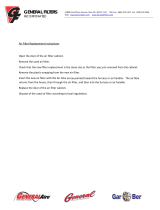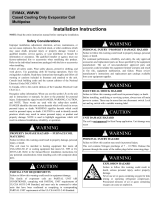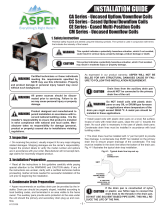
2
COIL INSTALLATION
WARNING:
Shut off all electrical power to the furnace and
outdoor condensing unit before performing any
maintenance or service on the system.
CAUTION:
The coil must be level to ensure proper
condensate drainage. An unlevel installation
may result in structural damage, premature
equipment failure, or possible personal injury.
Upflow Installations
1. Disconnect all electrical power to the furnace.
2. Installthecoilcaseonthefurnaceairdischargeopening.
Ifneeded,useacoilcaseadapterkittomatchthem
together. See Figure 1 (page 3) for case dimensions.
3. Seal the enclosure as required to minimize air leakage.
4. Connect the refrigerant lines as outlined in the
Refrigerant Line Connection section.
Downflow Installations
Thesecoilsmaybeinstalledindownowapplications.It
is required that the furnace and coil cabinets are securely
mounted together before setting in place. Fossil fuel
applications require the coil to be placed in the supply
air stream only.
Horizontal Installations
Standardcoilsmaybeinstalledinthehorizontalposition.It
is required that the furnace and coil cabinets are securely
mounted together and that a horizontal drain pan kit be
installed. See Table 2 for proper kit number.
Refrigerant Line Connections
1. Remove the cap (Figure 2, page 3) from the end of
the liquid line.
2. VerifypressurizationbydepressingtheSchradervalve
on the end of the liquid line. Listen for any escaping
gas.Ifthereisnopressure,testthecoilforleakage.
• If leakage is found, clearly mark the location of
the leak and return the coil to the distributor for
processing.
• Ifnoleaksarefound,thecoilmaybeinstalled.
3. Depress the valve to relieve all pressure from the coil.
4. Remove and discard the valve core and valve core
holder on the liquid line. NOTE: Do not reuse the
O-ring,valve,orthreadedvalveholder.
5. Remove the grommet from the suction line, making
note of its orientation and fit.
6. Remove the coil access door.
7. Remove the cap from the suction line.
NOTE: Depending on the manufacturing date, it may
be necessary to unbraze or cut off a copper cap, or
remove a rubber plug from the suction line.
8. Install theThermal ExpansionValve (TXV). Please
follow the instructions supplied with the kit. See
Table 1 for kit part numbers.
Table 2. Coil Specifications
F24-A F36-A F24-B F36-B F42-B F48-C F60-C F48-D F60-D
NominalCapacity,MinBTUH 18,000 30,000 18,000 30,000 36,000 36,000 48,000 36,000 48,000
NominalCapacity,MaxBTUH 24,000 36,000 24,000 36,000 42,000 48,000 60,000 48,000 60,000
Metering Device N/A N/A N/A N/A N/A N/A N/A N/A N/A
Nominal Airflow, Min (CFM) 800 1,000 800 1,000 1,200 1,200 1,600 1,400 1,600
Nominal Airflow, Max (CFM) 800 1,000 800 1,200 1,400 1,600 2,000 1,600 2,000
W - Width (in.) 141/2 141/2 171/2 171/2 171/2 21 21 241/2 241/2
H-Height(in.) 263/4 263/4 263/4 263/4 263/4 301/4 301/4 301/4 301/4
HL-HeightofLiquidLine(in.) 231/2 231/2 231/2 231/2 231/2 27 27 27 27
HS-HeightofSuctionLine(in.) 211/2 211/2 211/2 211/2 211/2 25 25 25 25
Connection - Liquid Line 3/8 3/8 3/8 3/8 3/8 3/8 3/8 3/8 3/8
Connection - Suction Line 3/4 3/4 3/4 3/4 7/8 7/8 7/8 7/8 7/8
HorizontalDrainKit 920265 920265 920265 920266 920266 920267 920267 920267 920267
WARNING:
This coil is pressurized with Nitrogen.
Avoid direct face exposure or contact with
valve when gas is escaping. Always ensure
adequate ventilation is present during the
depressurization process. Any uncertainties
should be addressed before proceeding
.
NITROGEN
HEALTH
FLAMMABILITY
REACTIVITY
0 Minimal Hazard
1 Slight Hazard
1
0
0






